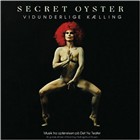Home » Jazz Articles » Album Review » Secret Oyster: Vidunderlige Kaelling
Secret Oyster: Vidunderlige Kaelling
What international reputation Secret Oyster had was as a group of intrepid jazz-rock soloists whose greatest claim to fame was sharing the bill on Captain Beefheart's 1975 European tour. So it's more than a little surprising that, while the group's more characteristic albums remain long out of print, The Laser's Edge has chosen to issue a beautifully remastered and expanded version of its music for the Royal Danish Ballet project Vidunderlige Kælling. The recording was originally titled Astarte when it was first released in 1975, referencing the specific piece where principal dancer Vivi Flindt—who performed the majority of the ballet in the nude—was painted entirely in gold, at considerable personal risk. This reissue is more appropriately named after the title of the ballet itself, conceived by Flemming Flindt, Vivi's husband and the Royal Danish Ballet's artistic director/choreographer.
Contemporary ballet pieces that use rock-informed music—even of the progressive variety—often fail the test of time, but the music on Vidunderlige Kælling succeeds on its own merits and is surprisingly fresh thirty years later. While lacking the avant-garde edge of classic Soft Machine and the harmonic/compositional complexity of Hatfield and the North, there is nevertheless a certain Canterbury feel to the album, which is fleshed out to 49 minutes with three additional previously unreleased tracks which were heard at the ballet. The textures are different—no self-respecting Canterbury band would use a Moog or string synthesizer—but the contrapuntal nature of the arpeggiated "Intro and "Outro bear clear precedence.
"Sirenerne, with saxophonist Karsten Vogel and guitarist Claus Bøhling's across-the-bar melody supported by Ole Streenberg's solid backbeat, parallels the similarly riff-based Karl Jenkins-era Soft Machine, as does the more atmospheric "Astarte, revolving around a keyboard/guitar arpeggio that develops into a restrained solo tradeoff vehicle for keyboardist Kenneth Knudsen and Bøhling—also heard on sitar. But whereas latter-day Soft Machine, as compelling as it was, often demonstrated a dangerous proclivity for excess, Secret Oyster remains ever-focused on the purpose of Vidunderlige Kælling, which is to support a group of dancers. "Solitude is gentle, lyrical, and just the slightest bit melancholy, while "Tango Bourgoisie —which features guest musician Palle Mikkelborg, well-known to fans of the ECM label—is aptly titled, tongue planted firmly in cheek.
Vidunderlige Kælling may not be wholly representative of Secret Oyster's full potential, but it remains an evocative and engaging album that will hopefully spark some interest in reviving the rest of the group's small but worthwhile discography.
Track Listing
Intro; Stjernerne Pa Gaden; Sirenerne; Astarte; Solitude; Tango-Bourgoisie; Bellevue; Valse du Soir; Outro. Bonus Tracks: Sleep Music; Circus Sax; Intro to Act II.
Personnel
Kenneth Knudsen: piano, electric piano, Moog, string synthesizer; Karsten Vogel: soprano saxophone, alto saxophone, string synthesizer; Claus B
Album information
Title: Vidunderlige Kaelling | Year Released: 2005 | Record Label: The Laser's Edge
< Previous
Six-String Lady
Comments
Tags
For the Love of Jazz
 All About Jazz has been a pillar of jazz since 1995, championing it as an art form and, more importantly, supporting the musicians who create it. Our enduring commitment has made "AAJ" one of the most culturally important websites of its kind, read by hundreds of thousands of fans, musicians and industry figures every month.
All About Jazz has been a pillar of jazz since 1995, championing it as an art form and, more importantly, supporting the musicians who create it. Our enduring commitment has made "AAJ" one of the most culturally important websites of its kind, read by hundreds of thousands of fans, musicians and industry figures every month.



















